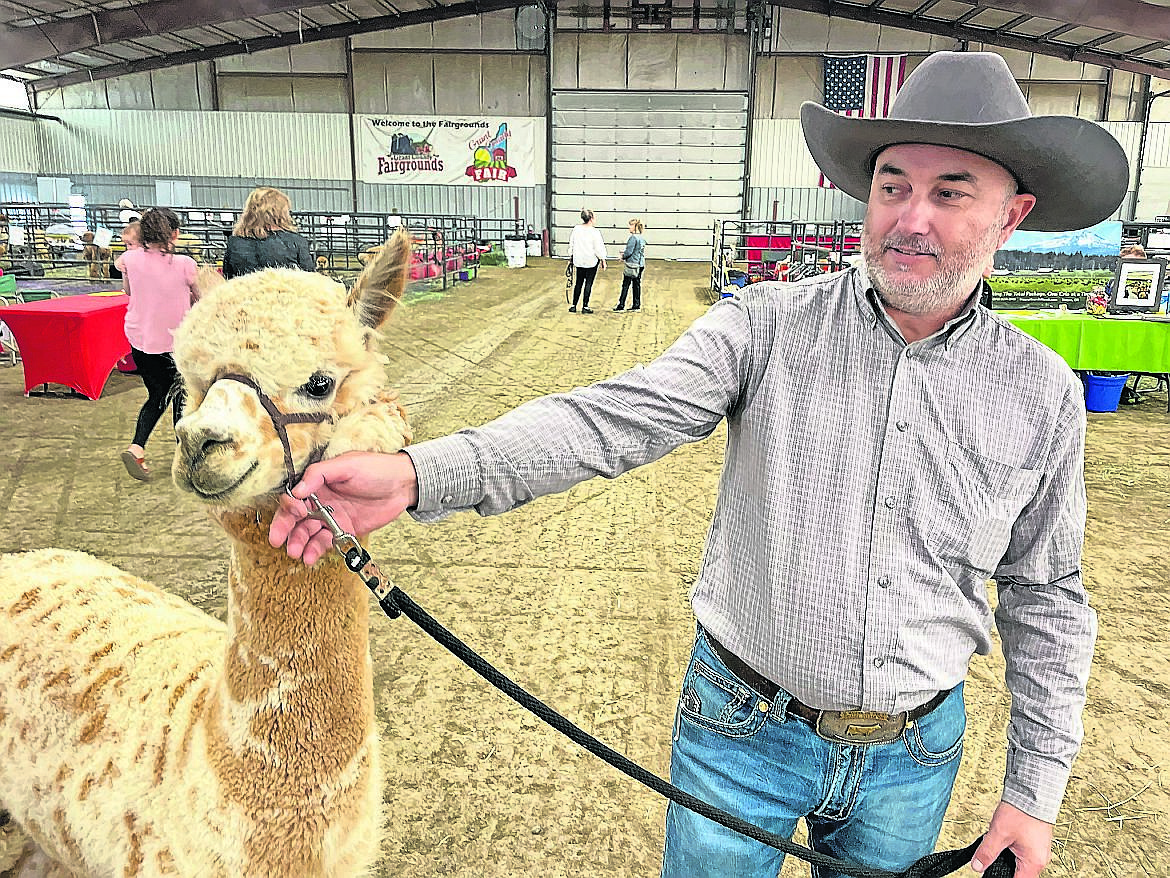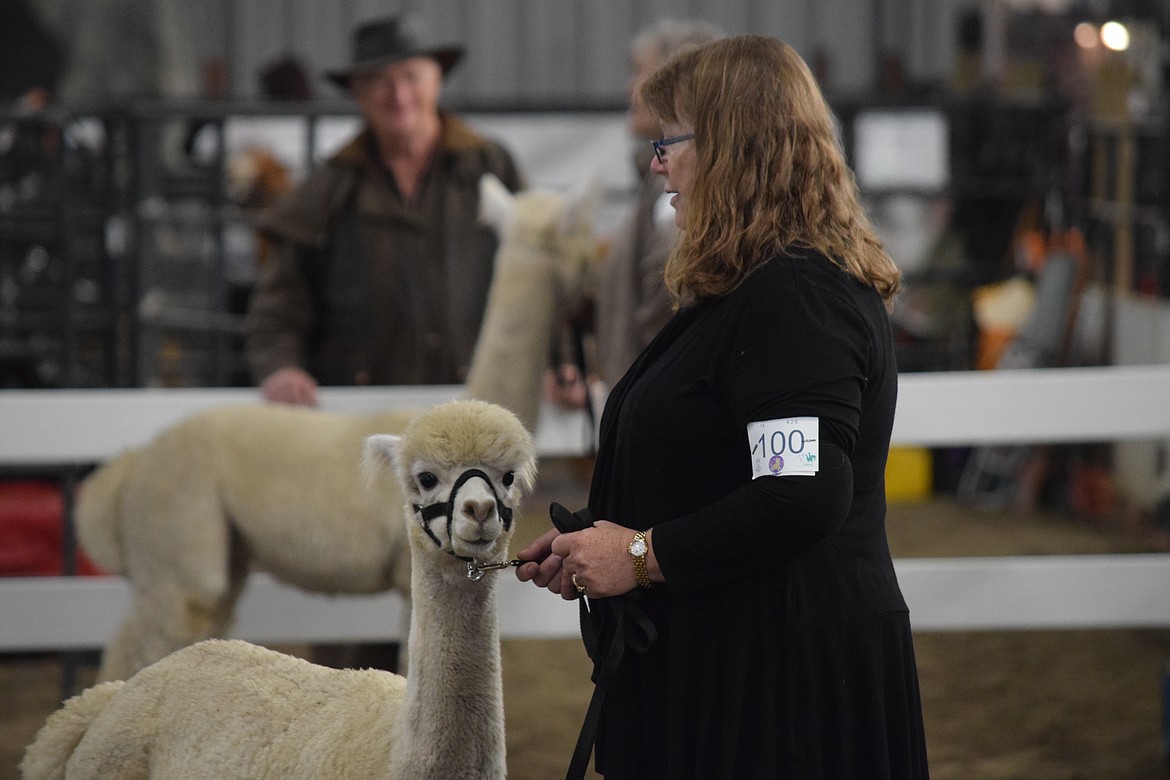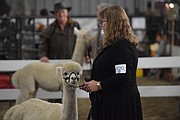Wool power: Alpaca ranchers gather for show
MOSES LAKE, Wash. — It was, on the face of it, just another Saturday in which the sounds and smells of agriculture wafted from the Ardell Pavilion at the Grant County Fairgrounds.
But the bleats and the grunts filling the pavilion on Oct. 8 came from animals you don’t often see in the Columbia Basin – alpacas. And there were scores of the South American camelids at the fairgrounds on Saturday. They were part of a two-day long AlpacaFest show organized by the Alpaca Association of Western Washington along with the Alpaca Owners Association and the Pacific Northwest Alpaca Association that brought ranchers to Moses Lake from as far away as California, Colorado and Montana.
“There’s actually about 400 alpaca ranches in Washington state,” said Mark Dodrill, an Auburn resident and head of the AAWW. “It’s the number two state for alpacas in the country behind Ohio.”
Dodrill said he’s been raising alpacas for about two years now and enjoys it because the animals are very even-tempered and easy to care for.
“We moved from the big city out to the country and wanted to do something different,” he said. “We found alpacas are excellent animals. They’re very easy to raise and they’re very calm, they don’t try to escape.”
Alpacas are native to the Andes Mountains of South America, and like their larger cousins the llamas, belong to the same family as the camel – large herbivores with spindly legs and long necks. They are bred primarily for their incredibly soft fleece, Dodrill said, which are used to make everything from socks to rugs.
“And you can use the fleece that comes off them, every part of it, for some sort of product,” he said. “The best part is what they call the blanket, that middle section there, and you can use that for things that touch your skin, like socks, hats and gloves.”
According to Jennifer Ely, the communications coordinator for the PNWAA, AlpacaFest is actually three shows — the Northwest Alpaca Showcase, which gives alpaca owners a chance to do some fitting and showing with their animals in a halter; AlpacaFest, a “walking fleece” competition that merely judges the quality of an animal’s wool; and AlpacaPalooza, which hosts both events.
“That’s what’s going to be happening all weekend,” Ely said. “It’s kind of a big deal in our industry. Our alpaca industry is very well supported nationally and regionally. So these regional affiliates have come together to do a joint show.”
The owner of Tahoma Vista Fiber Mill in Yelm, Jean Van Effen, processes alpaca wool and sells alpaca wool imports from Peru. She also raises 35 alpacas herself, so she’s more than familiar with both ends of the alpaca business. In fact, she was there on Saturday getting ready to show some of her animals.
“There is a lot of demand for alpaca, once people see how wonderful it is,” she said. “It’s an amazing fiber. It’s very versatile.”
According to Amber Miller, vice president and youth coordinator of the Olympic Peninsula Llama/Alpaca Rescue in Port Angeles, the Pacific Northwest is a good place to raise the animals, though their natural habitat in the high Andes is often dryer and cooler than this part of Washington.
“It’s actually pretty good climate-wise for them,” she said. “But if they’re in a pasture with a lot of moisture, their toenails will grow like crazy because they don’t have all the rocks and dry dirt to help keep them down. They have to have their toenails clipped.”
Miller said anyone looking to raise alpacas should have a small herd of at least three of them – they feel safer in groups – and at least an acre of land to raise them on.
“Some want them for lawn mowers, and some just because they’re pretty. Others are in it for the fiber,” she said.
“I just like the calmness about them, and I love the animal itself,” said Michael Gomes as he stood with his alpaca Cygnus, which sports a tan coat mottled with small caramel-colored spots. “They’re fun. They’re peaceful.”
Gomes came to Moses Lake with his animals all the way from Madera, California, and he’s looking forward to both the walking fleece and the halter competitions.
“The number one goal is to win,” he said.
“It gives some people a chance to get their alpacas evaluated by professional judges,” the AAWW’s Dodrill explained. “Everybody likes a little competition now and then for awards and prizes.”
Dodrill added, however, that he is not showing this year.
“We brought some last year, but there are much higher-quality alpacas here than mine. Which is great,” he explained.
This is only the second year the various regional alpaca associations have staged this show in Moses Lake, Ely said. She added that the show will likely make Moses Lake its permanent home.
“The hospitality here at the Grant County Fairgrounds has been phenomenal,” she said. “We love being here.”
Charles H. Featherstone can be reached via email at [email protected].




